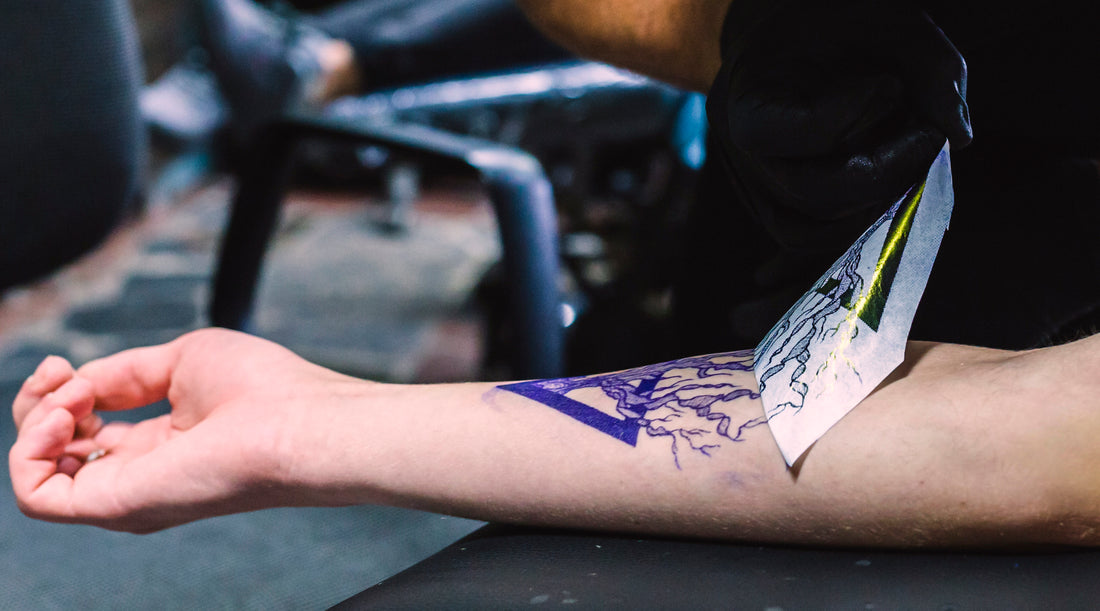How Does Tattoo Transfer Paper Assist Tattoo Artists?

Tattoos are a timeless form of self-expression, allowing individuals to showcase their personality, beliefs, and artistry on their skin. But what ensures that the intricate designs turn out perfectly on someone's body? That's where tattoo transfer paper comes into play. Tattoo transfer paper is a great helper for artists, providing a reliable way to translate their designs from paper to skin accurately. This tool has revolutionized the tattooing process, making it easier and more efficient for both artists and clients.
What is Tattoo Transfer Paper?
Tattoo transfer paper is a special type of paper used by tattoo artists to easily transfer a design from paper onto a client’s skin. But how does it work exactly? The transfer paper typically consists of several layers. The top layer is where the design is drawn or printed, and the bottom layer holds ink that gets transferred to the skin. When pressure is applied, such as tracing over the design with a stylus, the ink from the bottom layer transfers onto the skin, creating a temporary outline for the artist to follow.
This type of paper is important because it lets the artist make sure the design is right before it becomes permanent. It's really helpful for complicated or detailed tattoos where getting everything just right is super important. Once the design is on the skin, the artist can make changes if needed, making sure both they and the client are happy with how it looks and where it's placed.
Usually, tattoo transfer paper is used with a stencil solution. This solution helps the ink stay on the skin better and last longer during the tattoo process. It makes it easier for the artist to follow the lines without worrying about them fading too quickly. All in all, tattoo transfer paper is a useful tool that helps tattoo artists turn their designs into lasting art on their clients' skin.
How Can Tattoo Transfer Paper Be Helpful in Creating Tattoos?
No matter if you are a tattooist with rich experience or just an apprentice, it is necessary to understand how a piece of tattoo transfer paper works during the tattoo creation process and why it is so important and helpful.
1. Try Before You Ink
Tattoo transfer paper lets artists test the design on the client's skin before making it permanent. This is important because it gives both the artist and the client a chance to see how the design will look and make any needed changes, like resizing or repositioning.
2. Safe Color Experimentation
Another benefit is that it helps artists try out colorful designs with less risk. Tattooing vibrant and detailed designs directly onto the skin can be scary because of the durable ink. Using transfer paper, artists can see how different colors will look together and make sure everything lines up correctly, reducing mistakes and ensuring a beautiful tattoo.
3. Time and Effort Saver
Transfer paper makes the tattooing process quicker and easier. Instead of spending hours drawing intricate designs freehand on the skin, artists can use pre-drawn or digital designs to create stencils fast and accurately. This saves time and reduces strain on the artist's hands.
4. Consistency in Design
Using transfer paper also keeps designs consistent. If a client wants multiple tattoos with the same design, the artist can make sure each one looks exactly the same by using the same stencil. This is especially important for symmetrical or matching tattoos.
5. Confidence Booster
Lastly, tattoo transfer paper boosts confidence for both new and experienced artists. For beginners, it acts as a safety net, allowing them to perfect their technique without fear of making permanent mistakes. For seasoned pros, it streamlines their work, letting them focus more on their art rather than the setup.
How to Create a Tattoo Stencil?
Basically, there are two methods to create a tattoo stencil. You may choose to create one by hand drawing or print out the digital design onto the tattoo transfer paper, each having its own set of tools and techniques. Let's dive into these two methods you can use to create a tattoo stencil.
Method 1: Hand-drawn
Hand-drawing a stencil is a traditional method and involves a few straightforward steps.
First, what you'll need include;
- Tracing paper
- Transfer paper
- A stylus or pen
- An original design
- Gloves
- Transfer gel

Start by placing the tracing paper over your design and carefully trace it. Once you're satisfied with the traced image, place the tracing paper over the transfer paper and go over the design again with a stylus or pen. This will transfer the ink onto the skin when the stencil is applied.
Warm Tips:
- Ensure your hands are clean to avoid smudging.
- Use light, consistent pressure when tracing to get even lines.
- Keep the working area well-lit so you can see all details clearly.
Method 2: Print it Out
While hand-drawing has its perks, it also comes with drawbacks like inconsistencies and longer preparation times. Fortunately, there's a modern alternative – printing out the stencil. This method is faster and often more accurate, especially for complex designs.
If you want to print out a digital stencil, you'll need to prepare the following items:
- A computer or tablet with your digital design
- A4 Tattoo transfer paper
- A tattoo stencil printer (preferably one designed for tattoo stencils)
- Stencil solution or transfer gel
- Scissors (for cutting out the stencil)
- Gloves (to maintain hygiene)
By having these items ready, you can smoothly create and apply your digital stencil for tattooing.
A tattoo stencil printer can be a great helper here. These printers use thermal printing technology and are compact, making them portable and space-saving. Among various brands, MUNBYN stands out for its reliability and ease of use. With this machine, you can design and print tattoos directly from your phone, tablet, or PC using a versatile app. Simply load the transfer paper into the printer, finalize your design, and print it out.
Warm Tips:
- Make sure to use compatible tattoo transfer paper, as these printers do not support regular typing paper or A4 thermal paper.
- Double-check your design for any errors before printing.
- Always keep the printer clean to ensure optimal performance.
Compare the Two Methods
Which one should you choose? No matter you choose the hand-drawn tattoo stencil or the digital one, you have to face the advantages and drawbacks of each of them.
Hand-drawn Tattoo Stencil
Pros
- It can greatly help a tattoo artist improve their design skills.
- Artists can better manage small details like line thickness and shading when they draw the stencil by hand, leading to fewer mistakes and a quicker process during tattooing.
- The artist can pause and restart anytime during the creation of the stencil, making it a relatively flexible process.
- Hand-drawn stencils can be tailored to each client's body for a more personalized tattoo.
Cons
- One apparent drawback of hand-drawn designs is it takessignificantly longer compared to using digital tools or pre-made designs.
- There is a higher chance of minor errors or inconsistencies as it relies heavily on the artist's skill and attention to detail.
- If the stencil gets damaged, making a new one or creating a replacement takes a lot of time and effort.
- If the client needs a different size or slightly change the design, you have to redraw the whole design from scratch.
Printed Tattoo Stencil
Pros
- Create a tattoo stencil with a faster speed and save much more time than hand drawing.
- Able to make more complex designs.
- Resize or make slight changes of the design without redrawing the whole piece.
- Make adjustment until both the artist and the client are satisfied.
- Easily replicate designs for multiple clients.
Cons
- Limited flexibility for last-minute changes during the tattooing process.
- Requires reliable access to a computer and printer, as well as a printable tattoo transfer paper.
- The initial cost can be high since you need to by a specialized tattoo stencil printer.
- Less versatile compared to regular thermal printers since it is confined to print tattoo designs only.
Final Thoughts
Tattoo transfer paper has changed tattooing a lot. It helps artists work with more accuracy, save time, and keep things safe for both them and their clients. With transfer paper, artists can test designs first, make changes easily, and handle colorful and complex art better. This tool is a must-have in the tattoo world. Whether you're new or very experienced, using transfer paper can make your tattoos even better.




